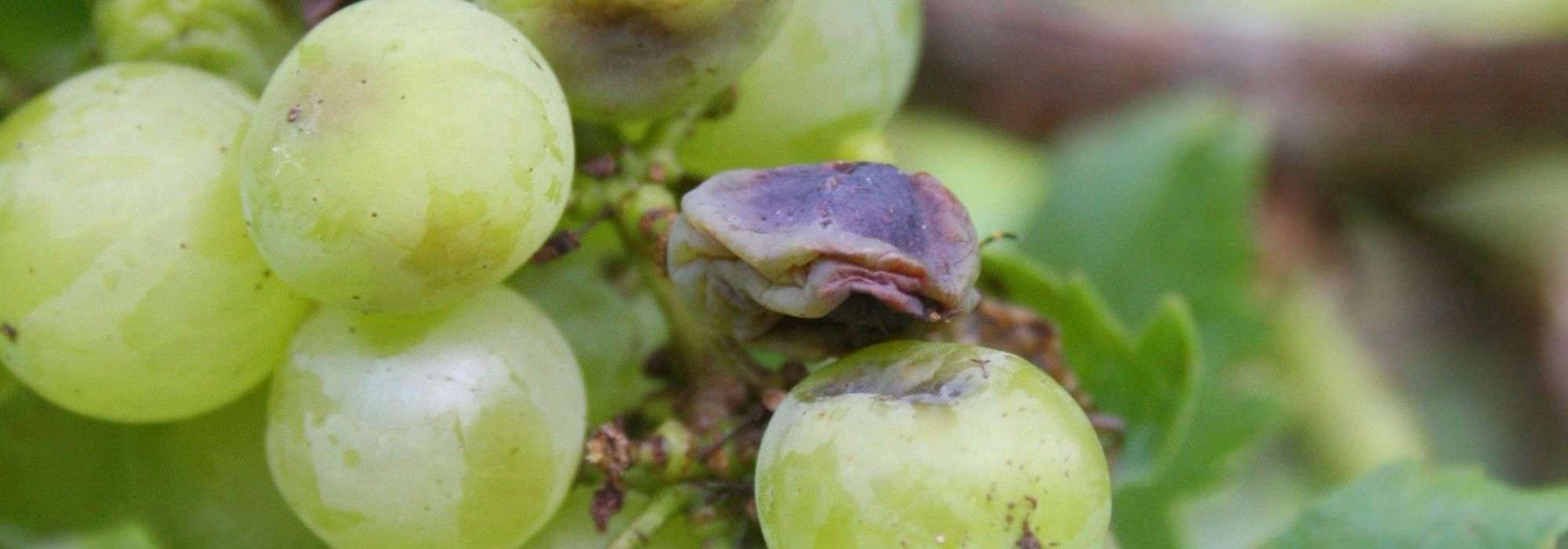
Vine diseases
How to prevent and treat them?
Contents
If grapevine (Vitis vinifera) is prized for its juicy, sweet pulp, it is also known for the frequency of its diseases. Although hardy and easy to grow, grapevine is susceptible to various fungal diseases and certain pests that threaten grape clusters, or sometimes its survival. Grapevine diseases are common. Downy mildew, powdery mildew, grey rot (botrytis) are the most common. Fortunately, good cultural practices can easily prevent these diseases on your grapevines. For these fungal diseases, use Bordeaux mixture at first signs.
Discover our tips to quickly make the right diagnosis and choose appropriate treatment so you can enjoy a fine grape harvest!
What is endangering vines?
Among many diseases that threaten your young grapevine plants, we can distinguish :
- Parasitic diseases caused by cryptogamic fungi, bacteria and viruses.
- Non-parasitic diseases caused notably by nutrient deficiencies (such as iron chlorosis in grapevine)
- Pests such as mites and insects such as the grape cluster worm
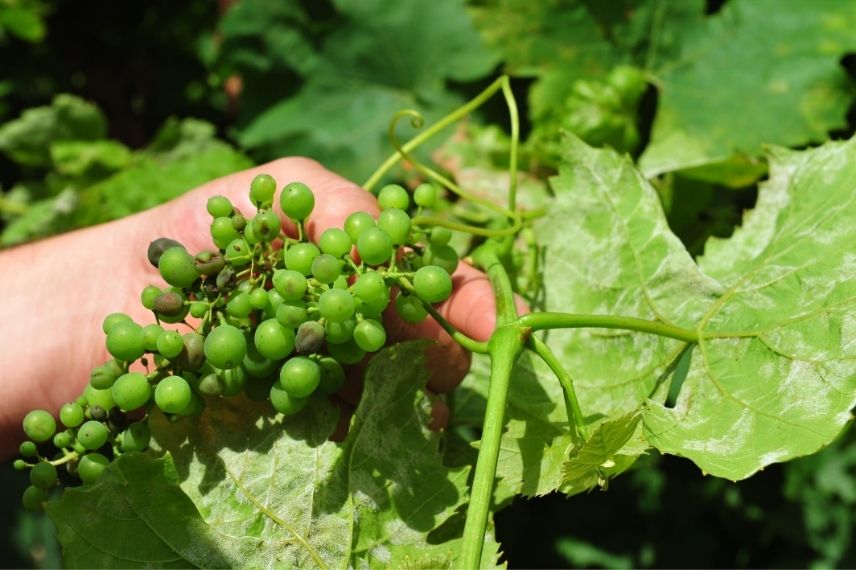
Read also
Powdery mildew or white diseaseHow to prevent grapevine diseases?
A grapevine planted in appropriate growing conditions will always be less vulnerable.
- Plant it in full sun, in a very warm position sheltered from prevailing cold winds, in well-drained soil.
- Planting on a slope will improve drainage. Ground that retains too much moisture promotes root rot and the onset of fungal diseases. Moreover, it will be hardier in well-drained soil.
- Choose disease-resistant grape varieties such as Ampelia® grapevines.
- Very close planting of grapevines encourages disease development. Prune and train the woody climbing stems regularly to prevent overly dense growth and to improve air circulation in the canopy.
- During hot, dry periods avoid watering, and if you do, do not wet the foliage.
- Limit fertiliser applications: grapevine is an undemanding plant that does not require regular feeding; overly rich soil can make it more susceptible.
In all cases, we recommend using organic products compatible with ecological gardening to enjoy grapes without chemical treatments.
Discover other Grapevines
View all →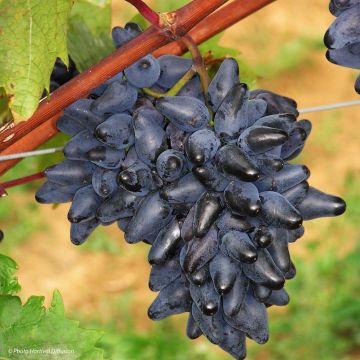
Available in 1 sizes
Available in 1 sizes
Available in 1 sizes
Available in 1 sizes
Available in 1 sizes
Available in 1 sizes
Available in 1 sizes
Available in 1 sizes
Available in 1 sizes
Available in 2 sizes
Downy mildew
Downy mildew (plasmopara viticola) is grapevine’s number one enemy. This parasitic fungus appears mainly during mild, rainy springs and summers, when temperature ranges between 16 and 22 °C. It spreads rapidly in rainy weather or during heavy dew, weakens the vine-plant, generally causing rotting of already formed grape berries and significant harvest losses. Good protection against downy mildew is essential.
Symptoms:
Leaves, inflorescences, clusters, tendrils and shoots are threatened because downy mildew attacks all aerial parts of plant, the young green organs of grapevine. Attacks can occur from the start of flowering: the rachis then turns brownish, becomes distorted, inflorescences wither and fall, destroying any hope of harvest. At first, large brownish-yellow, oily spots appear on upper surface of leaves. Then, a downy growth appears on lower surface of leaves. Afterwards, leaves brown and dry out. Very quickly, these spots spread to young woody climbing stems, which become covered with pale streaks, and to grape clusters that eventually rot on the plant after turning white (grey rot) and later brown-red (brown rot).
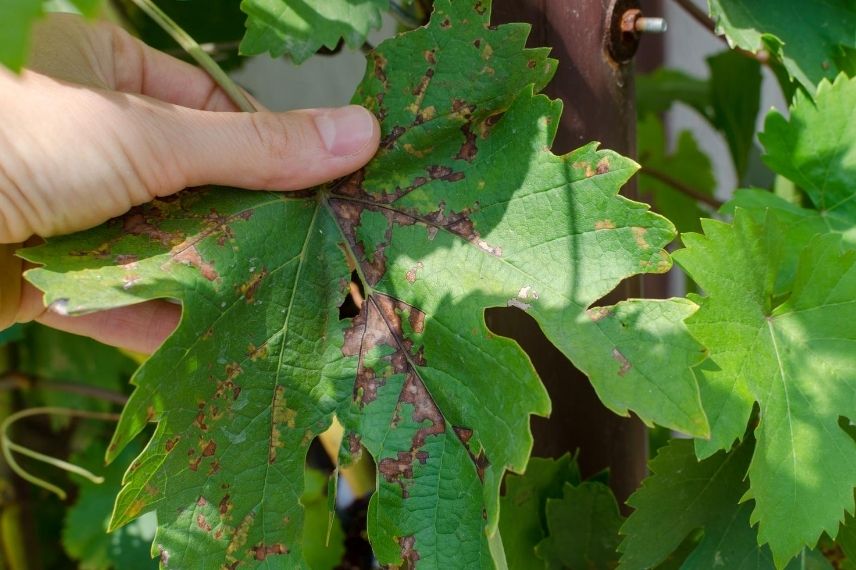
How to deal with it?
Prevention:
Control of downy mildew is mainly preventive. Grow varieties resistant to downy mildew. The best prevention is to choose less susceptible varieties, and this is possible. New varieties prove more resistant to diseases. This is the case for Ampelia vines, highly resistant to fungal diseases and requiring few or no treatments. Since phylloxera attack in 1863, a sap-sucking insect that decimated French and European vineyards, rootstocks from more resistant American grape varieties have also been developed.
- Space your plants sufficiently and train the woody climbing stems as they grow to improve air circulation and allow rapid drying of foliage, as downy mildew is favoured by humid conditions.
- On hot summer days, do not hose down your vine-plants! Always water sparingly at their base, taking care not to wet the foliage.
- As a preventive measure, spray Bordeaux mixture (15 g per litre of water), sulphur or horsetail manure. Repeat treatment if weather is rainy. Collect and burn affected leaves.
Treatment:
In case of severe attack, spray every 8 days with Bordeaux mixture or horsetail decoction: do not apply during flowering.
Read also
Botrytis or grey mouldPowdery mildew
Powdery mildew (white disease) is a common fungal disease caused by fungi. It attacks all organs of the vine, from leaves to shoots and clusters. Heat and excess humidity favour development, especially in April–May and late summer. Hardly visible at first, it becomes difficult to control once established.
Symptoms :
Leaves first develop oily, dusty spots, then the underside of the lamina blackens. A grey-white, farinose felt appears, then the edges of the lamina become crisped and infected young berries undergo necrosis and rot.
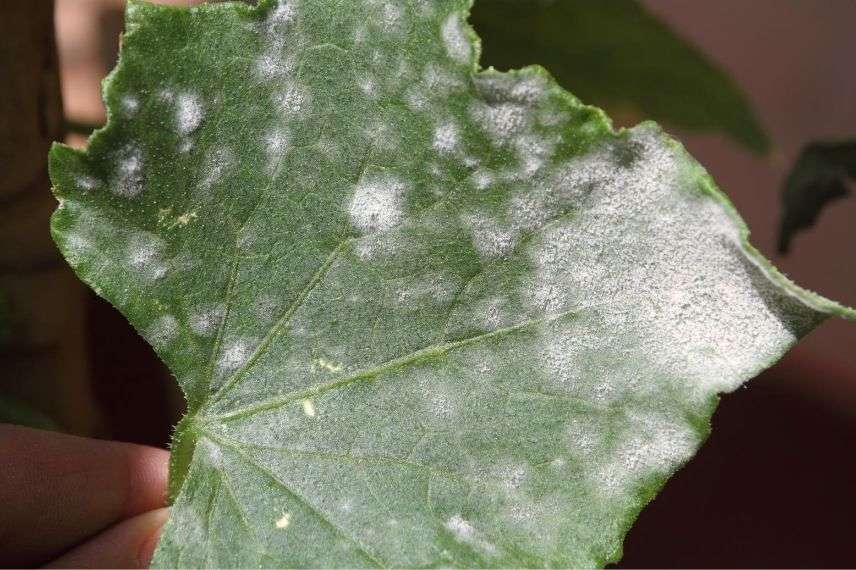
How to deal with it?
Prevention :
In late winter, prune to keep vine well aerated.
Limit watering and avoid wetting leaves and shoots directly; direct spray towards the base of the plant.
Spray a sulphur-based fungicidal treatment or a horsetail decoction at bud burst period, before and after flowering.
Limit spread by cutting out affected parts and burning them to prevent propagation.
Treatment :
If attacked, spray a sulphur-based fungicidal treatment at fifteen-day intervals or after rain. For optimal treatment efficacy, ambient temperature should be between 25 and 30°C.
Botrytis
Botrytis (botrytis cinerea), also called grey mould is a disease caused by a non-specific microscopic fungus. It develops rapidly at around 18–20 °C in warm, humid conditions. It primarily affects berries at ripeness.
Symptoms:
Leaves curl and take on a scorched appearance. They dry out and become covered with greyish felt on undersides. Contaminated shoots show brown spots. Grapes rot, brown and become covered with grey felt.
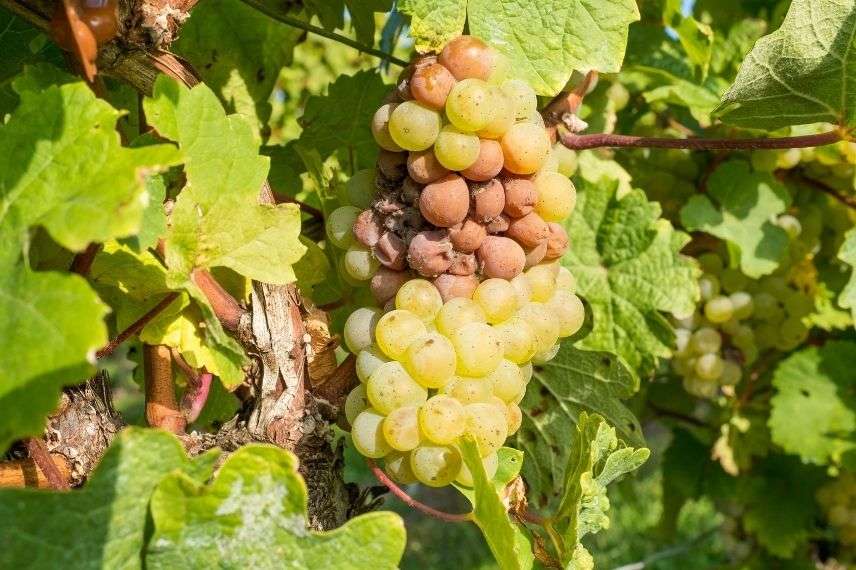
How to deal with it?
Prevention:
Spray Bordeaux mixture in autumn. Avoid high-nitrogen fertilisers.
Treatment:
Once present, it is difficult to eliminate. Remove diseased parts and collect affected fruit to prevent spread of fungus.
Main grapevine pests
Grape cluster worm and Eudemis
- Cochylis, more commonly called tortrix or grape cluster worm, is a lepidopteran, a small moth with ochre-yellow wings striped with brown. Its caterpillars perforate flower buds in spring then grape berries during summer, causing wounds in fruit that favour establishment of grey rot. It develops in cool, humid climate.
- Eudemis is mainly found around Mediterranean basin and prefers dry, warm climates. It is also ochre-yellow but smaller than Cochylis, and its caterpillars cause similar damage.
Prevention:
To prevent grape cluster worm attacks on vines, visible by appearance of threads of bristle woven by caterpillars, control is essentially via a biological control with the installation of pheromone traps (sexual confusion method) or preparations based on organic insecticidal Bacillus thuringiensis.
Erinose or vine leaf blister
This is a very common but harmless disease of vine, caused by tiny mites that lodge on underside of leaves creating greenish then reddish swellings or blisters from their feeding. A white felt turning to reddish-brown may also appear on lower leaf surface. Damage is generally not serious and does not require specific treatment other than a preventive application of wettable sulphur as soon as galls appear. This harmless disease has no impact on harvest.
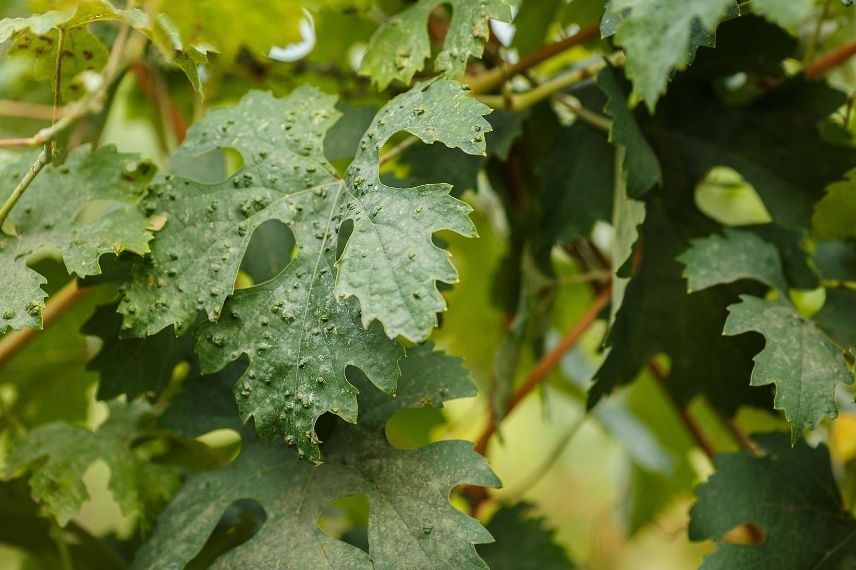
→ Discover now in our online shop all our environmentally friendly solutions to control diseases
Further reading
Discover our other advice sheets on grapevine :
- Subscribe!
- Contents
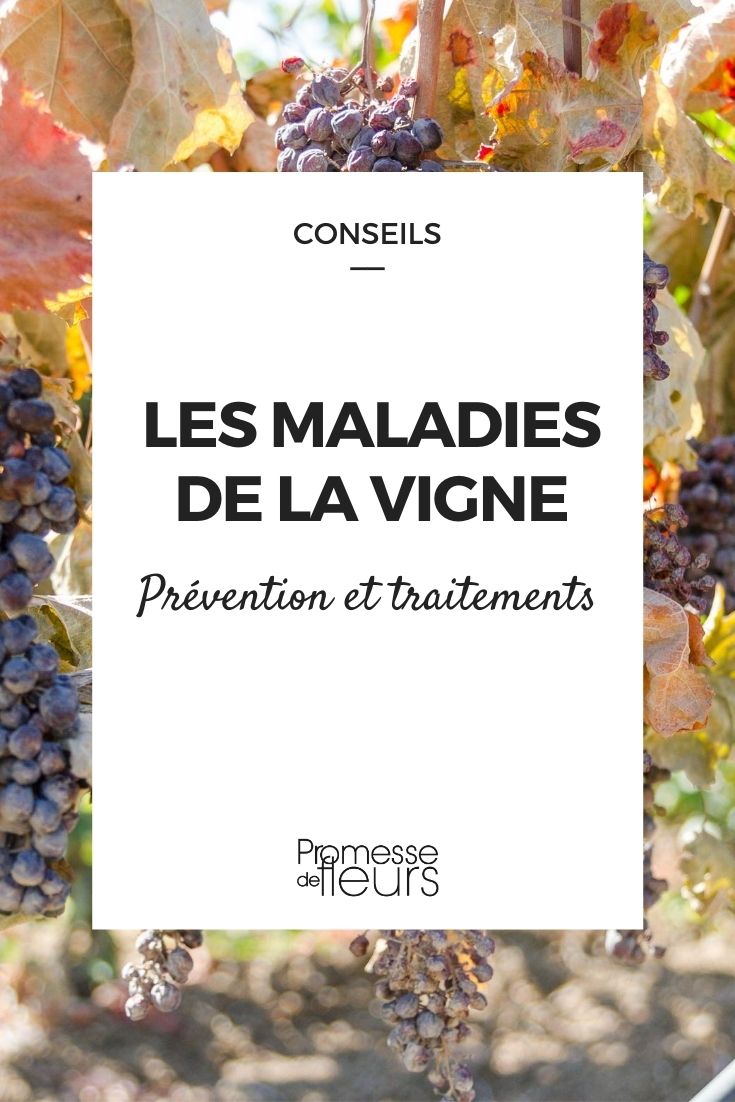































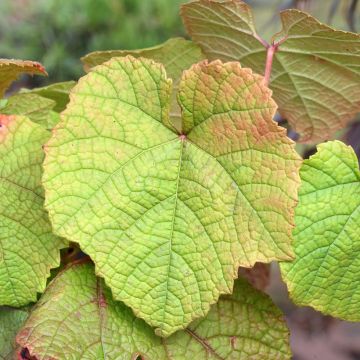

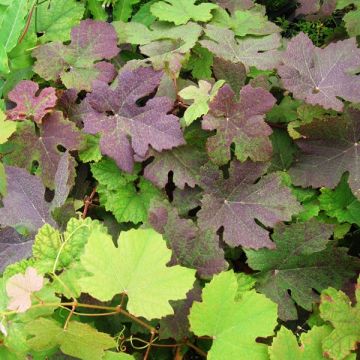
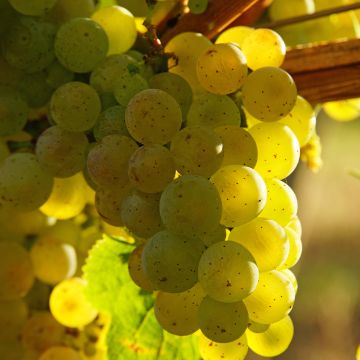



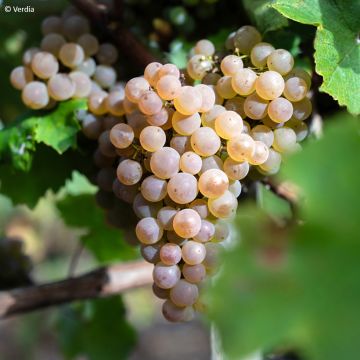

Comments